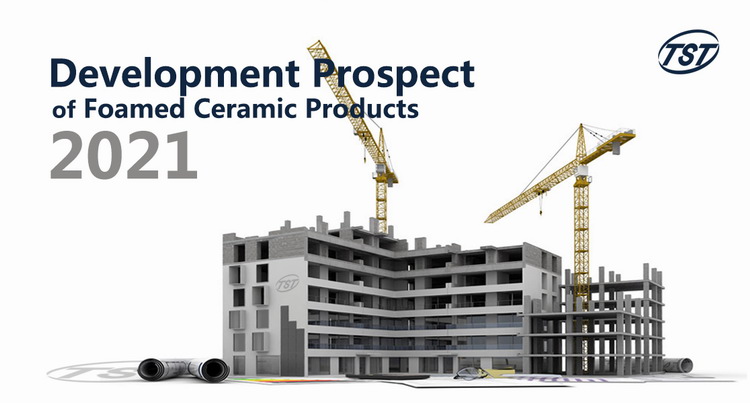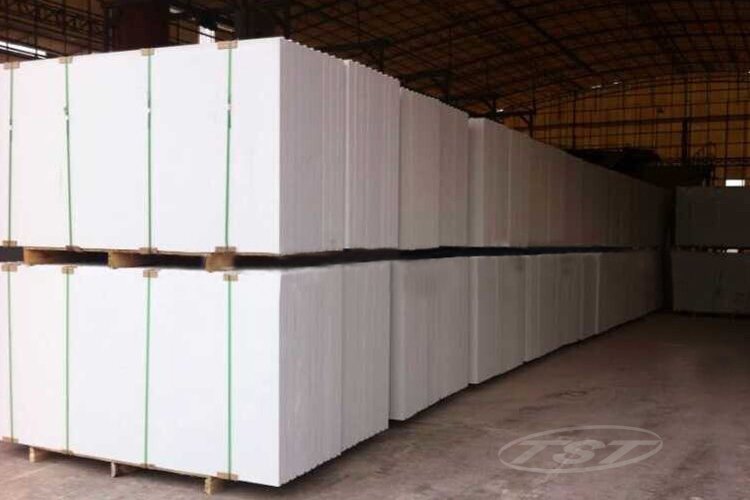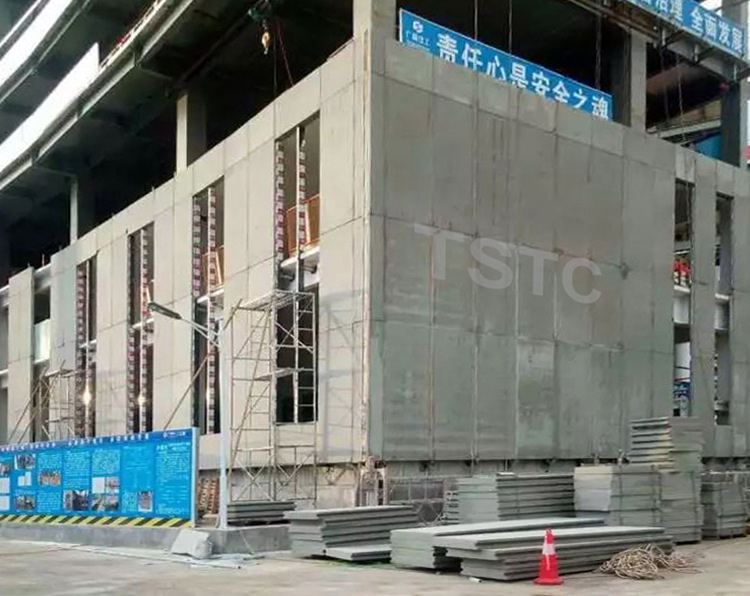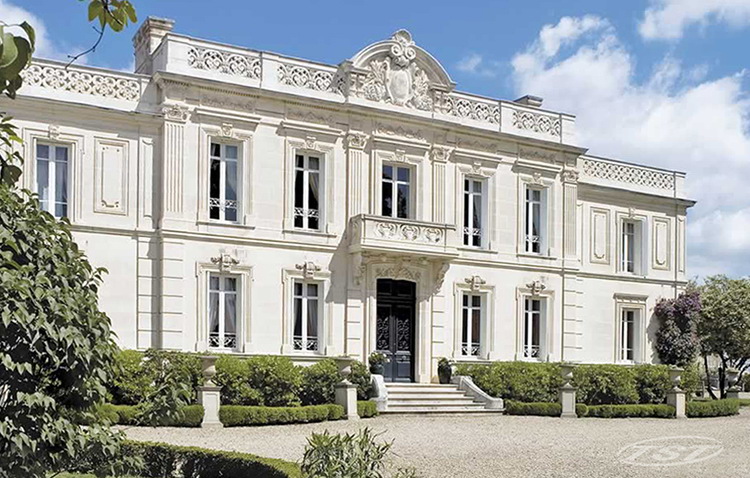Industry News
Development Prospect Of Foamed Ceramics Under the Trend of Energy Saving
Since the beginning of this year, the hottest topic in the ceramics circle has been rock slabs, and last year's highly anticipated foamed ceramics seems to be greatly reduced. Many people in this industry said that due to the long production cycle, high energy consumption, high prices, and low production capacity, the current sales of foamed ceramics are not optimistic. However, the reporter learned that at the end of May 2020, the foamed ceramic partition wall tunnel kiln of Inner Mongolia Jianneng Xinghui Ceramics has been put into full operation.

A technical veteran from Ruitao kiln introduced to the reporter that the rough specifications of the foamed ceramic partition wall panels produced by this production line are 2500×2500mm, and the finished product specifications after cutting are 600×2440mm, 4 pieces, and the rough thickness is about 14cm, the thickness of the finished product after processing is 12cm, which is currently the largest specification and thickness of foamed ceramic partition wall in China. In addition, for the first time, it has successfully used fly ash to exceed 80% in mass production. The energy consumption of this trial production is less than 80m3 of natural gas per cubic meter of finished product, which is a record low in the industry, fully automated loading and unloading...
It can be seen that in the big background of the country's promotion of green and energy-saving buildings and safe and environmentally friendly construction, foamed ceramics still have a lot to do.
What are the current technical bottlenecks in foamed ceramics? What are the pain points in practical applications? What is the development prospect... With these questions, the Ceramics Information reporter interviewed some industry professionals.
There are 45 production lines for foamed ceramics in China now, and the high unit production cost is not conducive to market promotion. As we all know, foamed ceramics are made of clay tailings, ceramic fragments, river sludge, coal gangue, fly ash, mine tailings (lithium tailings, copper tailings, vanadium tailings, iron tailings, red mud, etc.) The main raw material is a closed-cell ceramic material with high porosity that is baked at high temperature using advanced production technology (dry/wet pulverization, roller kiln/tunnel kiln firing) and foaming technology.
As a new type of inorganic building material, foamed ceramic has the characteristics of light weight, non-combustibility, heat preservation, heat insulation, waterproof and moisture-proof, and also has the environmental protection concept of solid waste utilization and circular economy, which is derived from industrial solid waste. At present, polished brick waste slag is widely used in the industry, and gradually expanded to the application of solid wastes such as river silt and coal gangue.
With the implementation of policies to support the development of prefabricated buildings by the national and local governments, and the demand for solid waste treatment, 2020 will become a critical year for the comprehensive utilization and remediation of industrial solid waste. Therefore, foamed ceramics are still worthy of attention.

According to the reporter’s information organization, the current Chinese domestic companies focusing on foamed ceramics include Guangdong Jinlv Energy Technology, Inner Mongolia Jianneng Xinghui, Liaoning Hanking, Guangxi Toco, Guangxi Chaochao, Guangdong Huatao, Jiangxi Sinoma, Anhui Longda, etc. Combined with some published information, there are currently 45 foamed ceramic production lines nationwide.
Ma Zhongping, marketing director of Jiangxi Sinoma New Materials, also conducted a comparative analysis to reporters. Compared with other ordinary wall building materials, foamed ceramics, as closed-cell foamed ceramic materials, have light weight, high compressive strength, and good moisture and waterproof performance. This is its greatest advantage. The transformation of this advantage into the construction industry can reduce the building load, reduce the process of wall moldy and waterproof, improve construction efficiency, and achieve rapid installation and completion.
Speaking of the shortcomings of foamed ceramics, Ma Zhongping pointed out that due to the existence of internal foam pores, it is an ordinary performance in terms of fire resistance. In addition, because foamed ceramics is the only high-temperature fired wall building material, its unit production cost is relative to other traditional building materials such as aerated concrete blocks, autoclaved aerated concrete wall panels, and lightweight cement composite wall panels. Is the highest, which is not conducive to promotion in the civil construction market.
According to industry sources, at this stage, the high unit cost of foamed ceramics is mainly reflected in higher fuel costs. He estimated that in terms of fuel, the unit cost of foamed ceramics is more than 1,000 yuan per cubic meter, which is 30 %-50% higher than the unit cost of traditional cement mortar materials.
Speaking of the main markets for foamed ceramic applications, the person in charge of the relevant department of Guangdong Jinlv Energy Technology believes that foamed ceramics are a good material and a good product. Non-penetrating, non-absorbent, and millimeter-level inorganic ceramic materials are naturally light-weight, high-strength, fire-resistant, soundproof, waterproof, moisture-proof, mildew-proof, non-deformable, and heat-preserving.
Utilizing the characteristics of high compressive strength, nailing and hanging, good flatness, light weight and high construction efficiency of foamed ceramics, it can be used as indoor partition board. According to the cost budget of Party A's owners and real estate construction developers, high -end Grade A office buildings, high-end villas, high-end real estate in first-tier cities, or five-star hotels, large airports, museums and other public buildings are recommended. Using the characteristics of light weight, moisture-proof , waterproof, inorganic fire-proof, non-combustibility, etc. of foamed ceramics, it can also be used for deep processing such as carving and cutting to make building components such as ceramic decorative art lines , ceramic decorative waist line, ceramic window cover, ceramic cornice required for real estate construction to replace traditional GRC cement components or even stone components. This is the mainstream market for foamed ceramic applications.

He further added that using foamed ceramics with light weight, moisture-proof, waterproof, non-combustibility and other properties, it is also used as a green body to make composite ceramic sheets and composite natural marble new wall materials, so that it has both building walls and The effect of decoration and beautification. It is also used as a partition wall blank, after bonding internal wall tiles and sanitary ware, it is made into an integral bathroom and pushed to the construction market. Utilizing the thermal insulation, heat insulation , non-combustibility, moisture-proof, waterproof and other characteristics of foamed ceramics, self-insulating exterior wall walls are also being explored, eliminating traditional exterior wall thermal insulation materials such as organic polystyrene boards, rock wool and other materials. It can achieve safety and fire protection, and it can be used as a partition wall, which has advantages in comprehensive cost.
In addition, he emphasized that since the foamed ceramic partition wall is a new type of wall material, its production technology and construction application technology are still being explored and summarized in practice. It takes a long process for foamed ceramic materials to enter the building system application, and many difficulties need to be overcome.
The equipment pain point of foamed ceramics lies in how to expand production capacity while ensuring low energy consumption? At present, foamed ceramics is in the groping stage. In terms of production technology, the product technology, formula materials, and production process of foamed ceramics have not been unified due to different product development directions, and they are still not mature enough. Whether it is in terms of external wall insulation board or indoor partition wall board, it is a new type of wall building material product in building construction applications, and there is no reference object that can be compared with the target.

It is understood that the construction industry now has production standards for foamed ceramics. At present, the foamed ceramic partition wall refers to the national standard "Lightweight Partition Wall Strips for Construction" (G/BT 23451-2009) and the industry mainly standard " Foamed Ceramic Partition Wall Panels" (T/CBCSA 12-2019), and internal control of the enterprise Standard Q/JYLN 3-2018.
Regarding the important production equipment of foamed ceramics-firing kilns, after recent years of exploration, a clear consensus has been reached in the industry. Foamed ceramics can be divided into two main categories according to the application direction of the product: Insulation board and internal wall partition board.
The performance requirements of these two product directions are completely different. To make external wall insulation boards, the products are required to be thin, with high thermal conductivity requirements, ≤0.1w/mk. The smaller the coefficient, the stronger the insulation performance to replace Polystyrene extruded board, a traditional organic thermal insulation material. The foamed ceramic partition wall requires the product to be a thick, high-strength, and light-weight slab. With reference to general building walls, the thickness is between 10-15 cm, in the north, the requirements are higher, mostly more than 20 cm, and the compressive strength should reach more than 6 MPa. These two products have different product performance requirements, which determines that the production of external wall insulation board is more suitable for roller kiln firing, and the production of indoor partition board is more suitable for multi-layer tunnel kiln firing.
Senior technical personnel of Foshan Ruitao kiln frankly said that the equipment pain point of foamed ceramics lies in how to expand production capacity under the condition of ensuring low energy consumption. At this stage, there are two types of equipment - roller kiln and tunnel kiln. Generally, roller kiln is single-layer and tunnel kiln is multi-layer (at this stage, it is three layers). This can effectively save energy and improve production capacity at the same time. However, these two kiln types have their own advantages and disadvantages, which can not be generalized. Specifically, the roller kiln can achieve fast burning, and the section temperature difference, annealing and cooling section are well controlled, but its production capacity is not high; The tunnel kiln has a relatively large capacity, but its firing cycle is long, the section temperature difference is not easy to control, and the control of different layers in the cooling section needs to be explored. It is worth mentioning that at present, its energy consumption is mainly concentrated in kiln furniture. If the kiln has a breakthrough or the layout of firing area is adjusted accordingly, it will greatly save energy consumption, which needs a groping process.
At this stage, he believes that the pain points related to the production technology of foamed ceramics mainly focus on whether the foaming is uniform, whether its specific gravity meets the standard, and whether its thickness meets the standard. There should be no big bubbles (big bubbles will break), and the thickness should not be too thick (generally speaking, the thickest at this stage is 14cm for the blank and 12cm for the finished product). Generally, enterprises make the finished product 8cm and 10cm at the maximum. If it is too thick, there will be uneven foaming and plate breaking due to uneven internal stress release (there will be no fracture when leaving the kiln), However, after placing, or cold working, or the finished product breaks after warehousing). If we want to solve the above problems, we need the comprehensive cooperation of formula, raw materials, technology and equipment. Making foamed ceramics is an overall engineering concept, and it will not be successful to solve a problem.
As for the pain point of the practical application of foamed ceramics, the person in charge of relevant departments of Guangdong Golden Green Energy Technology believes that as the main material of buildings, the use of foamed ceramic partition boards is huge, and the adoption of new wall materials will risk innovation and building quality problems, which is for the construction party or Architectural Design Institute of large-scale construction projects with strict requirements, It is also unacceptable. Especially since 2014, after the state implemented the lifelong responsibility system for the quality of five main bodies of construction engineering, the Architectural Design Institute, especially in charge of structural design and material selection, has become more cautious.
He stressed that in terms of actual construction, the construction engineering companies and construction teams that really master the construction technology of foamed ceramic partition board are also few in the country. Most real estate construction engineering companies have not heard of foamed ceramic partition board, and most construction technicians need construction training. With the improvement of relevant standards, it is believed that the construction industry will slowly accept it after several large benchmark projects are completed.
Green energy-saving building materials usher in a good opportunity for development, and the market prospect of foamed ceramics remains to be seen.
Regarding the development of foamed ceramic wallboard, Mr. Ma believes that the key depends on the balance between product performance and production cost. Performance must be subject to the needs of the application scenario, and the production cost must be subject to the needs of the market. If the main market is the internal partition wall of the building, the outstanding performance requirements are light weight, high strength, and sound insulation. Part of the household wall and fire protection measures also require high fire resistance. At this time, moisture-proof and waterproof performance becomes secondary. Therefore, focusing on market demand, how to change the production process, reduce production costs, and expand the construction market share is to play an important role in the development of the foamed ceramic industry. At present, with industry manufacturers' continuous exploration of foamed ceramic composite wall panels, through-hole foamed ceramics and other aspects, coupled with the technical update of ceramic kiln machinery and equipment manufacturers, I believe that the future of the foamed ceramic industry is still bright.
Talking about the development prospects of foamed ceramics, the person in charge of the relevant departments of Guangdong Jinlv Energy Technology said that foamed ceramics may have more room for development in the next few years. The development of foamed ceramics has a great relationship with the support of national policies, the general trend of real estate development and consumers' consumption consciousness. In recent years, the country has vigorously promoted green and sustainable development, the development of a circular economy, and consumers have paid more and more attention to home health. Green energy-saving building materials have ushered in a good opportunity for development. In recent years, the country has also accelerated the promotion of the development of prefabricated buildings, and introduced some policies and measures to increase the area of prefabricated buildings. In 2019, China's prefabricated construction area is about 110 million square meters, the scale of prefabricated buildings is about 210 billion yuan, and the total output value of the prefabricated construction industry is about 316.8 billion yuan. The market potential is quite broad.

Looking back in May of this year, a fully automated, intelligent, green and efficient new production line was successfully ignited at the Foshan production base, and Xiangguocheng Construction Technology Investment Holdings (Shenzhen) Co., Ltd. signed a key project in the second quarter of 2020 in Rongchang District, Chongqing. ..... It can be seen that the series of big moves by Guangdong Jinlv Energy Technology not only show its firm belief in the development of foamed ceramics, but also indicate that it is very optimistic about the development prospects of foamed ceramics.
Finally, he also pointed out that by increasing investment to promote the maturity of foamed ceramic production technology; relevant building material specifications are becoming more mature, and foamed ceramics are suitable for high-quality buildings and prefabricated buildings with their own advantages, which will improve the country’s entire building. Both energy consumption and fire protection have great benefits, and foamed ceramics, a green building material, will usher in a huge development opportunity.
Categories
News
Contact Us
Contact: TSTC Building Materials
Phone: +86 15042736579
Tel: +86 15042736579
E-mail: service@tstcbm.com
Add: Shentong Road, Lagu Industrial Park, Fushun City, Liaoning Province , China .